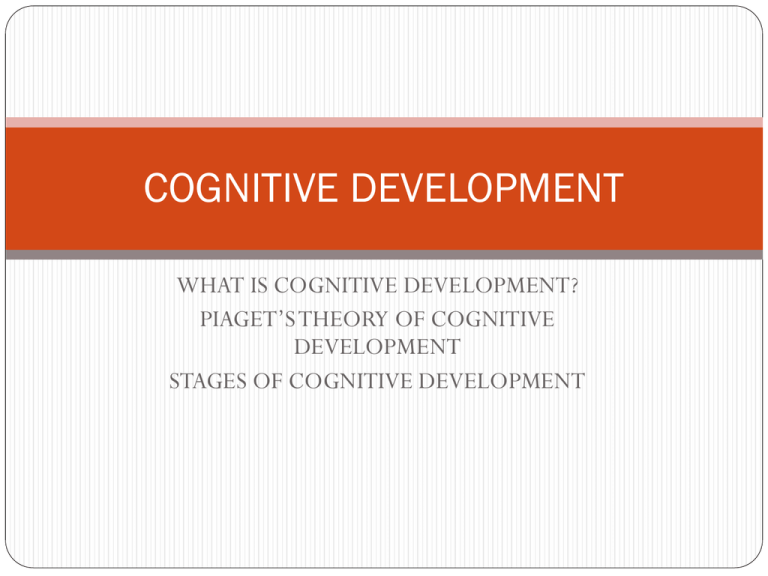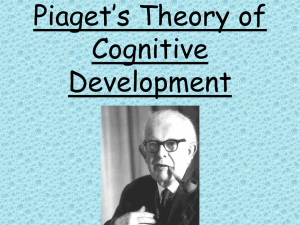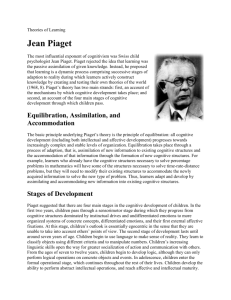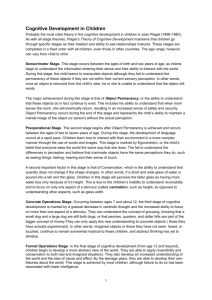cognitive development - The State University of Zanzibar
advertisement

COGNITIVE DEVELOPMENT WHAT IS COGNITIVE DEVELOPMENT? PIAGET’S THEORY OF COGNITIVE DEVELOPMENT STAGES OF COGNITIVE DEVELOPMENT WHAT IS COGNITIVE DEVELOPMENT? Changes in thought processes that enable children to acquire and use knowledge about the world (Papalia, D and Olds, S; 1992:120). Cognitive development is the change and increase of the following: Knowledge and understanding, intelligence and consciousness, thinking, creating, generating plans and strategies, reasoning, inferring, problem solving, classifying, fantasizing, imagining, perceiving, memorizing, manipulating mental images, concepts, rules and symbols. Piaget’s theory of cognitive development Piaget (1896-1980), a Swiss psychologist, has provided a comprehensive explanation about children’s cognitive development. His explanation is based on longitudinal and crosssectional studies of children’s development. He used interviews, observations and puzzles. Ideas Child development is a series of different qualitative stages tied with changes in schemata. The developmental process is a connection between physical maturation and experience with the physical environment. The child is intellectually active in the process of cognitive development. Spontaneity, guidance and motivation to do activities are needed to. Process of cognitive development Organized knowledge (mental schema) Level of understanding (mental operation) Ability to manipulate objects (physical activities) Intelligence, which is adaptation to the environment (Piaget cited in Davenport ,C (1994) is a universal attribute which characterizes all human beings. Piaget developed key concepts to explain the development process; schema/schemata, adaptation, assimilation, accommodation and equilibration . Schema: the basic cognitive structures consisting of organized patterns of behavior used in different kinds of situations (Papalia, D: 2001). Children use mental schemes to understand their world. Schemes represent ideas about what things are and how we deal with them. Structures: the psychological units of the mind that enable us to think (Elliott et al; 2000) Children’s curiosity, exploration and interpretation allow it to construct its own world. Adaptation: the process of becoming successfully adjusted to the environment as a result of changing and expanding the mental schema. It is a gradual, continuous and repetitious process that constructs and reconstructs knowledge. Adaptation occurs through the two complimentary processes of assimilation and accommodation (Papalia, D: 2001) leading to equilibration (Rosser, R. A: 1984). A child knows that this is a cup for tea, plate for food, glass for water. Assimilation: The process of incorporating new information into the existing cognitive structure (Papalia, D; 2001:38). New events and information build mental structures which then help children’s to fit their understanding of reality and build more organized and expanded mental structures. The existing schemes help in acquiring new experiences and knowledge. New information is absorbed, interpreted and construed in terms of their presently available way of thinking. During assimilation the schema is not completely changed but it is just trying to change. Questions asked; what is this? What is it used for? Is it the same as that or this? How can it be used? How is it resemble with other things? Accommodation is the process of changing ways of thinking, doing, behaving, perceiving and believing to come to agreement with the reality. The cognitive organization becomes adjusted to handle new information or new events. Children who encounter unfamiliar information, incorporate the new information into their intellectual structure and change it to fit the new information. Assimilation and accommodation are interconnected in every cognitive activity from birth to death. Dominance of one leads to dysfunctional behavior. Equilibration is the process of balancing assimilation and accommodation. This occurs when children regulate their schemes to a state of equilibrium. Therefore intellectual development and the acquisition of knowledge is continuous because the processes of assimilation and accommodation never ends. Cognitive stages of development according to J. Piaget He has identified four approximate stages All children should pass through all the stages in order. Stages are not skipped but the rate may differ from child to child. The stages are: 1. sensory motor, 2. preoperational, 3. concrete operational and 4. formal operational SENSORY MOTOR (0-2 YEARS) It is called sensory motor because infants build their mental schema by using sense organs and movements of their bodies. (0-1 month): Infants use reflexive actions to explore their bodies. 1-4 month: Forming habits by repeating pleasurable behaviors that occur by chance. No object permanence 4-8 months: Pleasure shifts from the body to external objects by discovering the interesting results of objects. Actions are object oriented and intentional; For instance they like to play with objects that produce sounds. Partial object permanence can be observed. 8-12 months:. Awareness of causality realizing that they can cause something to happen. Behavior becomes more deliberate and purposeful. Ability to anticipate events is also observed. Object permanence partially develops. This helps them to use symbols to represent things in their minds so they can think about them. 12-18 months: children purposely explore new possibilities with objects and exploring the results. They become curious, do various actions to see results e.g switch on or switch off light. They devote trial and error to solve problems using indirect means. 18-24 months: They start to use symbols, mentally represent objects and events. Through symbols they can think about events and anticipate consequences. They are goal-oriented and no longer confined to trial and error in solving problems. Object permanence is fully developed. PREOPERATIONAL STAGE (2-7 YEARS) Achievement: Object permanence/constancy; think about objects, events and people who are absent and perceive their connections. Use of symbols; ability to present thoughts, object and events using symbols. Language development; increase of vocabulary that expands their imagination and communication with people. Classification: according to criteria; shape, size and color, starts at rudimentary level and develops gradually. Awareness of adult roles, responsibilities and behaviors and trying to play those roles. Engage in symbolic /melodramatic/imaginative plays. They are curious, ask many questions and demand immediate answers, an indication that: their schemes allow them to coordinate events and objects. they start to use logic (at a very low level). they don’t have enough information and behavior to get answers from their own selves. Limitations at Preoperational stage : Problem of centration: concentrating on only one feature of a thing and neglect others. This is demonstrated by children’s inability to understand: Conservation principles: that some properties of an object remain the same regardless of changes in other properties Reversibility : returning something into an earlier state. This leads to illogical conclusion (Check Piaget’s studies in Papalia et al; 2001:pp 254-255 & Santrock, J;1999:pp206-208) Ego-centricism: thinking only on their own perspective or point of view, everything is for their own sake, everybody thinks is in the same way, have the same interest. What is good for them is good for everybody (Read experiment of a mountain in Papalia, D & Olds, S;1992: pp 190-192). Reason is still illogical although some traces of logic can be observed. CONCRETE OPERATIONAL STAGE (7-11 YEARS) Achievements Ability to de-centre They can transform and reverse objects, no longer deceived by appearance. Less egocentric; they think on the other point of views, can communicate more effectively and understand things without seeing them. Logical thinking develops but only on physical objects they can touch, see and hear and in the present time. They form concepts, see relationships of familiar objects and situations and solve concrete problems. Classification and discrimination according to similarities or differences, size or shape, color (higher level). Difficulties in abstract thinking; still depend on concrete environment they are more practical minded in their thinking. Spatial relationships: Ability to know a way to and from school, madrasa, market. Class inclusion: think simultaneously about the whole and parts. Seriation: arranging things according to size; the tallest to shortest Transitive inference or transitivity: logic of understanding relationship between two objects when the relationship between another object and one of the two is known. Example If A has more than C and B has more than A so, C has less than B. FORMAL OPERATIONAL STAGE (11- OVER Children reach at their pick of cognitive development. Thinking and reasoning do not depend on concrete situations or objects. They can also think on propositions, hypotheses and abstract concepts. Look at problems at different angles and possibilities and think of many alternative solutions. Process and use a lot of information acquired through experience for making decisions, judgments, reaching to a certain conclusion or solving a problem. Ability to apply principles and facts in solving a problem Design their own ways of solving a problem Ability to establish relationship of things, events, situations or ideas based on experience or information through various ways Can do experiments, interpret situations, participate in debate on social and political issues. This development occurs gradually and begins at lower level to upper level, from simple situations to complex situations. References Davenport, G.C (1994): An Introduction to Child Development (2nd edition). London: Collins Educational Elliot, S et al (2000): Educational Psychology: Effective Teaching, Effective Learning; McGraw Hill, Boston. Erikson, E ‘Childhood and Society’ in Diessner (1997): Sources: Notable Selections in Human Development. New York: Dushkin. Papalia, D et al (2001):Human Development (eighth edition). Boston: McGraw Hill. Rosser, R & Nicholson, G (1987): Educational Psychology: Principles and Practice. Boston: Little Brown and Comp. Santrock, J (1999): Psychology;The Science of Mind and Behavior. Dubuque: WCB. Brown & Benchmark.






